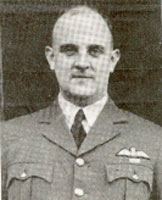The Airmen's Stories - F/Lt. E C Deanesly
Edward Christopher Deanesly was born on 27th January 1910 in Wolverhampton and educated at Wellington College. The family name had been Sly but gradually changed after a Miss Deane married into the family. However, no record has been found of a formal change.
EC Deanesly's father, Edward Deanesly, was a distinguished surgeon, who made a significant contribution over many years to the development of what became the Royal Hospital, Wolverhampton. He was also a Wolverhampton town councillor and a founding director of the Sunbeam Motor Car Company.
EC Deanesly worked for Sunbeam after leaving school. He was commissioned in the 6th Battalion of the South Staffordshire Regiment (TA) on 31st December 1930 as a 2nd Lieutenant.
He gained a private pilots licence at the Gloucestershire Aero Club on 14th April 1936. At that time his address was in Cheltenham (Licence ID photo below).

He resigned his commission and joined 605 Squadron AAF in early 1937 and he was then commissioned on 18th March.
With the AAF embodied on 24th August 1939, Deanesly was posted to 152 Squadron, when it was reformed at Acklington on 1st October.

At the time 603 Squadron at Turnhouse was receiving Spitfires and its redundant Gladiators were to be transferred to 152 Squadron. On 10th October Deanesly was instructed to fly a Hawker Hart to Turnhouse with Sgt. T Mycroft as his passenger. Deanesly was to return to Acklington with Gladiator K7929 and Mycroft would return the Hart.
The weather deteriorated. Deanesly became lost and eventually landed in a field on the Isle of Arran. He took off again, landed at Prestwick to refuel and reached Turnhouse.
The Gladiator was not ready and it was decided that Mycroft would return to Acklington in the Hart with Deanesly following in the Gladiator when he could. No weather report was obtained and it transpired that conditions to the south had worsened. A shepherd, James Buchanan, witnessed an aircraft flying low along a valley in foggy conditions. He lost sight of the aircraft, heard it again overhead and then there was a crash and flames, apparently on the northern slope of The Cheviot, in the Cheviot Hills. He reached the scene but was unable to approach the burning wreckage. He then walked several miles to the nearest telephone and, the next day, guided a search party to the crash site, where the body of Sgt. Mycroft was recovered.
The subsequent inquiry concluded that the primary causes of the accident were the weather conditions and Sgt. Mycroft's choice of route. A contributory factor was F/O Deanesly, as the senior person, allowing Sgt. Mycroft to fly the return journey without Deanesly as a guide. Today a cairn marks the crash site.
The squadron acquired Spitfires, starting in December and on 12th July 1940 moved to Warmwell, Dorset, where a key duty was defending the Portland naval base. Nicknames were allocated on the squadron and the tall and burly Deanesly became 'Jumbo'.
On the 25th Deanesly shared a Do17 and a Ju87. His Spitfire, K9901, was damaged by return fire from a Ju87, which punctured his glycol tank. He ditched in the Channel south of Portland, was picked up by the tug Empire Henchman, transferred to an RAF ASR launch, landed at Lyme Regis and admitted to hospital, wounded. He was operational again by 25th August.
Deanesly was shot down again on 26th September during a combat with Me109s twelve miles south of the Needles and baled out, wounded. He was rescued by a Royal Navy launch and landed at Swanage. His Spitfire, K9982, crashed into the Channel.
After a spell in hospital, Deanesly arrived at St. Eval Fighter Sector HQ on 15th December from 152 Squadron at Warmwell, on temporary duty as a Fighter Controller.
On 23rd November 256 Squadron had been reformed at Catterick as a night-fighter unit and Deanesly joined it in early 1941 as a Flight Commander.
Over the Birmingham area during the night of 10th/11th April Deanesly, with Sgt. WJ Scott as his gunner in a Defiant, destroyed a He111, on 3rd/4th May they shot down a Ju88 over Merseyside and a Do17, which crashed in North Wales and on 7th/8th May they downed a He111 over Manchester, which fell at Hazel Grove, Cheshire, with the crew baling out and becoming PoWs.
Deanesly was awarded the DFC (gazetted 30th May 1941) and Scott the DFM. They were decorated by the King in October.

Above: Deanesly (left) and Scott
Deanesly took command of 256 Squadron in September 1941 and led it until April 1942. He commanded RAF Castle Camps until October, being then posted to West Africa, where he was involved with maintaining the aircraft ferry route from Takoradi to Egypt.
After commanding 298 Wing in the Middle East from January to August 1943, Deanesly took over 114 Wing until March 1944, when he was posted back to the UK. He became CFI at 107 OTU, Leicester East, training pilots on Dakotas for paratroop and glider-towing operations.
Deanesly took command of 575 Squadron in December 1944, a Dakota unit. He took part in the Rhine crossings in March 1945, towing a glider.
He was released from the RAF in September 1945 as a Wing Commander.
He began a plastics company, PDI, in Birmingham and eventually employed around 150 people.
Christopher Deanesly died on 19th February 1998. He had met his wife 'Kuni', the former Kuniganda Helen Gill, when she was a WAAF officer serving at Warmwell in 1940. Her father had been an officer in the Royal Engineers.
|